According to the EPA, 75% of American waste is recyclable. However, only 30% of that waste ends up recycled.
This includes construction waste, which is a significant threat to the environment and human health and therefore needs to be managed properly.
Unfortunately, a lot of construction waste ends up in landfills even though it’s perfectly suited for recycling or even reuse.
We are sure that protecting the environment is in your best interest, which is why we will share five tips for recycling construction waste with you.
In this article...
Build Using Standard Dimensions
The first tip we have for you is to use standard dimensions while building stuff. This is because dimensional planning helps reduce the amount of materials needed.
To be more precise, if you stick with standard dimensions instead of coming up with unique ones, you won’t have to worry about the leftovers from the cutting required to adapt materials to unique dimensions.
This tip is number one on our list because there’s only one thing better for the environment than recycling, and that’s reducing the waste created. That’s exactly what you would be doing by adhering to this tip.
And besides, going with standard dimensions will also save you time, effort, and money. In the screenshot below, taken from Reddit, you can see that many people have this in mind when devising their projects.

House components tend to have standard dimensions that the majority of contractors use.
For example, if you know that residential ceilings have a standard height of 3,000-3,600 mm, it’s much easier to calculate exactly how much material you’ll need to create this space.
When it comes to windows, the size depends on many factors, such as the dimensions of the room, the direction of the wind, etc., but you can find some of the standard measurements in the table below.

And when it comes to room sizes, you should opt for standard-sized wallboard and plywood sheets to minimize waste. To better illustrate this, you can look at the minimum and maximum standard room sizes in the table below.

So, using standard dimensions while building is a great way to minimize construction waste since the less material you have to cut off, the less waste will be produced. Plus, you will be saving time and money.
Reuse Materials for the New Projects
Reusing materials for new projects is an excellent way to recycle construction waste. By reusing, we primarily mean repurposing materials that have previously been a part of another project, while maintaining their original form.
Those materials can be altered, refinished, or resized; however, they can’t be reprocessed. The less the materials are altered, the greater their economic and environmental value.
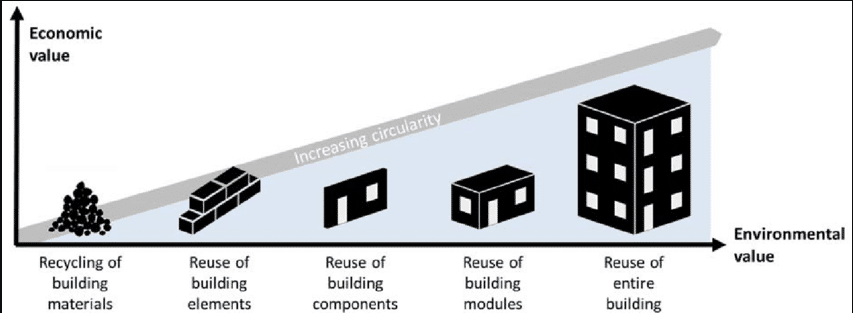
You can repurpose whole objects, such as doors, window frames, walls, and entire structures.
Additionally, materials that can be reused include brick, concrete, aluminum, steel sections, and untreated timber. For instance, demolished concrete can be used as aggregate for fresh concrete, and untreated timber can be used as firewood.
For instance, there are houses made entirely of reused materials, and some of them are true works of art, like The Collage House in Mumbai, India.

The Collage House front facade is made from doors and windows of demolished houses and was sourced locally, so the costs of transport were also kept low.
The flooring of the house has also been made from recycled materials, such as fabric waste, discarded slivers of cut stone, and even the beams of old houses.

This house is the perfect example of the old saying: “One man’s trash is another man’s treasure.”
It’s also worth mentioning that the reuse of building materials could significantly reduce the construction industry’s carbon emissions. In 2018, the construction industry accounted for 39% of process-related carbon dioxide emissions, which is a lot.
Sara Morel, chief executive at Savo, believes that for this reason, reclaimed materials should become an obligation and not only an option.
“The best way in which architects could reduce their material carbon dependence is through reuse.”
In conclusion, one of the smartest ways to limit construction waste is to reuse the materials for new projects. Not everything can be reused, but you can still recognize some great opportunities to put previously used materials into your future projects.
As environmental activist and BBM Sustainable Design co-founder Duncan Baker-Brown puts it, existing buildings are the material stores of the future.
Train Your Workers
When it comes to handling construction waste, it’s crucial to ensure that all of your workers are familiar with the recycling possibilities.
If the waste segregation procedures are properly done at the construction site, you will save a lot of time and money because there won’t be much need for sorting later.
Therefore, you need to train your workers on what is considered trash, what is recyclable or reusable, and how to find value in waste.
One way to do that is to encourage them to obtain certificates in sustainable deconstruction methods.
There are specialized institutions and training programs that can help you with this, such as RE-USE Consulting, which offers that type of training.
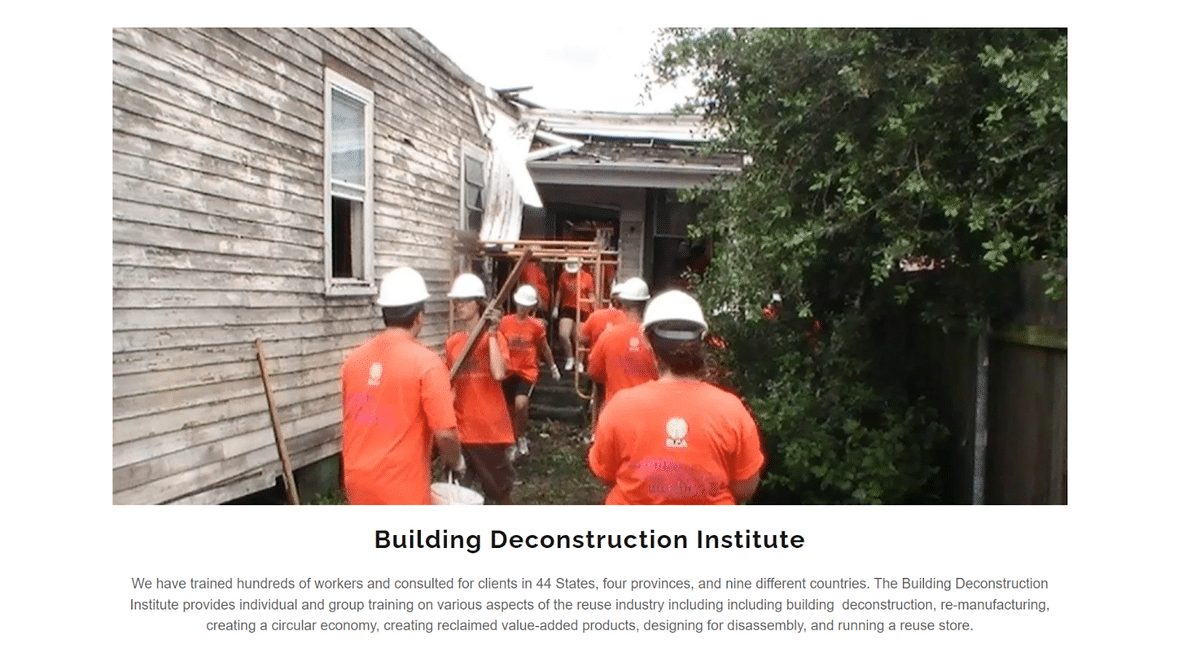
Simply put, deconstruction is an environmentally friendly alternative to demolition. Carefully trained deconstruction crews will salvage as many materials as possible, saving them from being disposed of at landfills.
Check out this timelapse to see how the process works.
You can see how the metal components of the building are salvaged so they can be used again in another structure.
Basically, 90% of the materials can be saved during the deconstruction process if this process is carried out with care and by trained professionals.
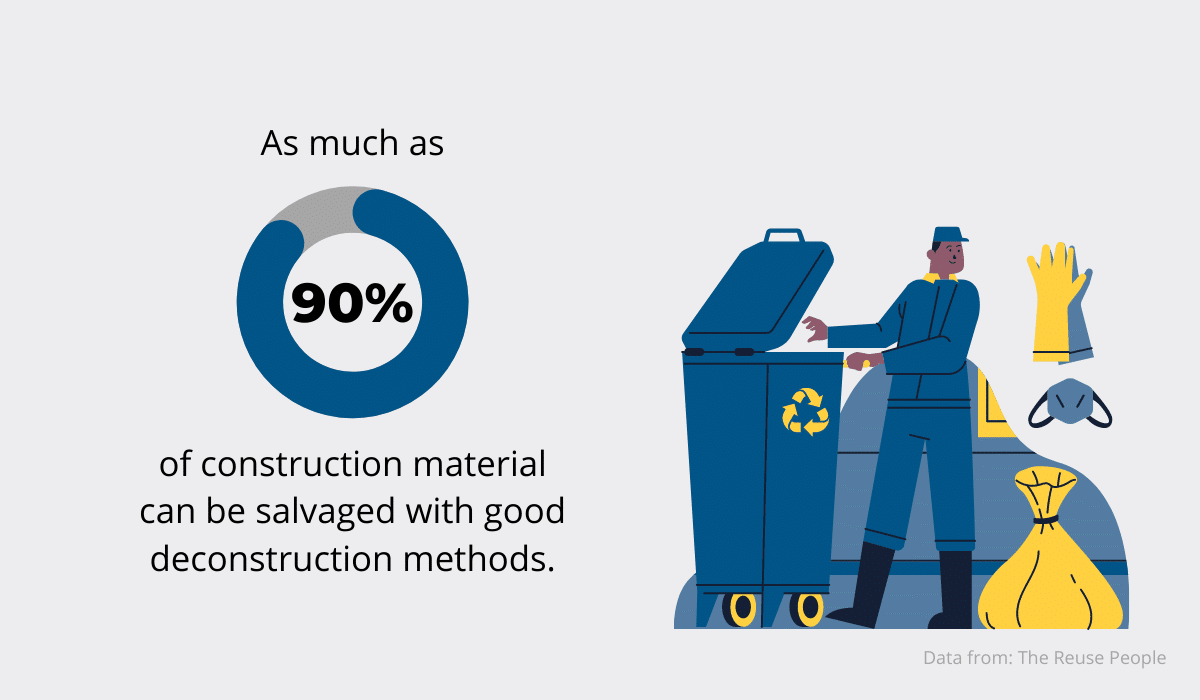
After providing your workers with the proper education on waste management, you can encourage them to adhere to the proper procedures by giving them verbal praise or, even better, adding bonuses to their salaries.
So there you have it: training your employees on waste recycling techniques such as deconstructing can drastically reduce the waste in the landfills and produce valuable, reusable materials.
Come Up With a Recycling Plan
Planning for recycling ahead is a surefire way to manage the waste created at the site.
If your construction team knows what the plan is, they can act accordingly to ensure waste will be properly sorted, disposed of, and prepared for transport.
The main decision you’ll need to make is whether to recycle on-site or off-site. Opting for on-site sorting will involve sorting your materials into separate bins.
These bins are then taken to the appropriate facilities specializing in that particular type of material.

However, if you decide to go with off-site sorting, you will need to put all of your waste into a single mixed recycling load, which is then sorted for you by the facility.
It’s important to mention that off-site recycling typically saves time because you simply drop all recyclable materials into one container.
On the other hand, on-site sorting is the best way to ensure recycling as much of your construction waste as possible. So we would recommend on-site sorting if you have high recycling goals.
It is particularly important to manage the recycling of two types of materials: those that generate the greatest amount of waste and, conversely, those that are not found in large quantities but are highly sought after, such as bricks and metals.
You can use a template for that, like the one below.
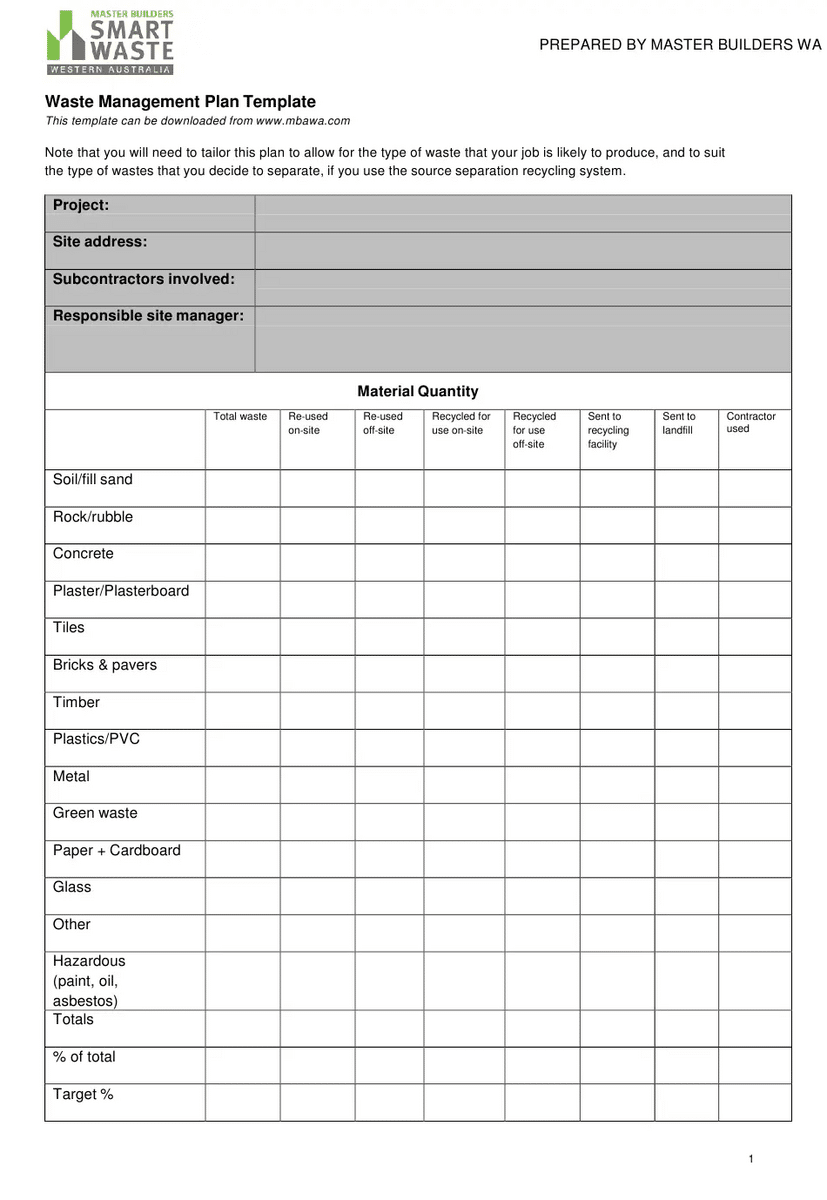
Note that the last row is titled “Target %”. That’s a very useful category to have because you can define how much material you want to recycle, giving your entire team a waste management goal to work toward.
There’s a lot to consider here, which is exactly why recycling plans are so important.
The best advice we can give you is to come up with a recycling plan before you start any construction work so that you’re not left with a worksite full of waste.
Donate to Local Charities
Local charities and recycling businesses are often willing to accept and sometimes even remove items they want to resell or use for a future project.
For instance, whether you are deconstructing or demolishing a property, you’ll often be able to look for ways to donate old furniture, fixtures, or other unnecessary materials.
Special charities like Habitat for Humanity, Goodwill, and the Salvation Army take all of these items and repurpose or sell them.

You may find that they can even clear out larger items such as doors, cabinets, and kitchen or bathroom fixtures with minimal effort on your part.
You can make an appointment with these charities through their websites or by phone and wait for them to come and pick everything up.
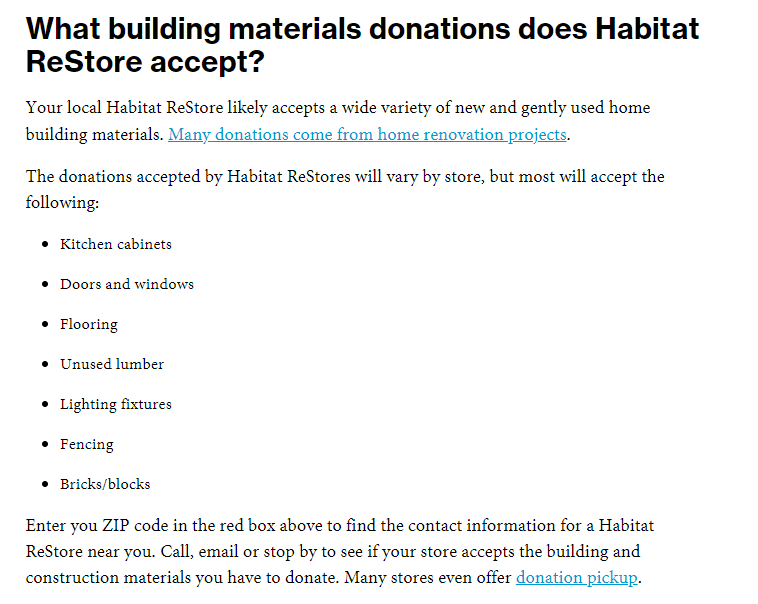
The benefit of working with local charities is that you benefit your communities and a number of people in your area.
Once charities receive the materials, they immediately look for ways to reuse and resell them. They often use the donated materials to build high-quality, energy-efficient homes at lower costs, which is pretty impressive.
For example, Habitat for Humanity has built and repaired over 107 houses solely with the use of donations.
Besides, when you donate, not only can you reduce waste, but you can also deduct a significant amount from your taxes, making the whole endeavor much more affordable.
In short, donating to local charities is an excellent way to recycle your construction waste and help someone else along the way. Try it!
Conclusion
Now that you’ve read our five tips, it’s time to incorporate recycling into your construction business.
We can’t stress the importance of recycling in the construction industry enough; it saves energy and reduces landfill waste.
Besides, by improving your recycling habits, you can help keep the environment clean and your wallet full, so make sure to start today.
Good luck.










